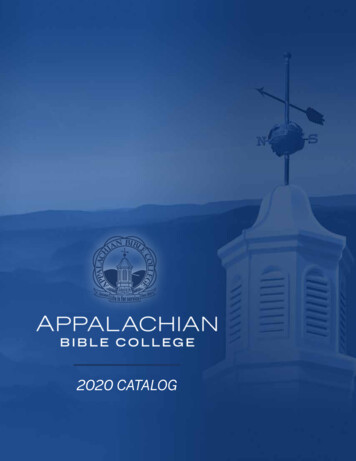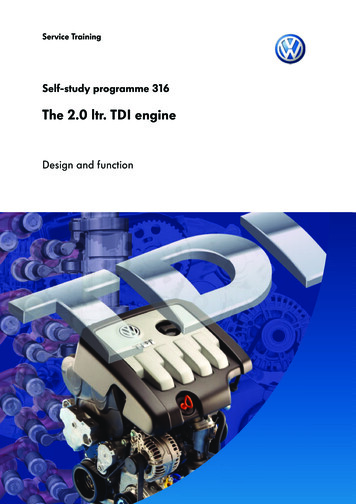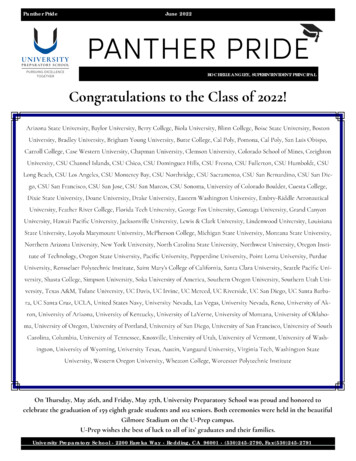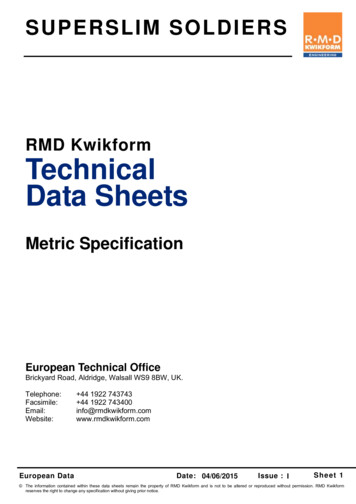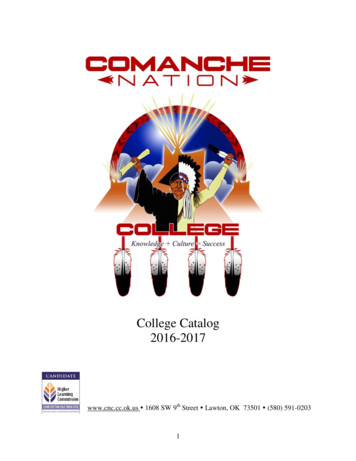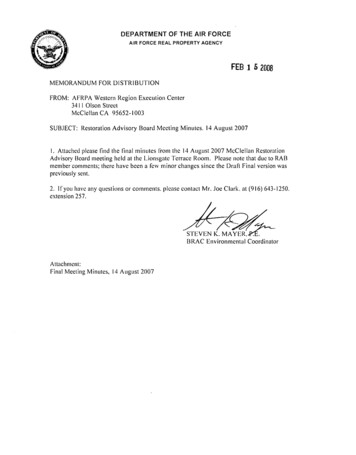
Transcription
DISTRIBUTION LISTFinal 14 August 2007 Restoration Advisory Board Meeting MinutesElectronic CopiesHard CopiesRobert Blanchard, RABAdrian DeWald, RABRandy Orzalli, RABWilliam Clements, RABGary Collier, RABTJ Vargas, RABPaul Green, Jr., RABPaul Plummer, RABBetsy Weiland, RABAlexandra Snyder, RABNathan Dietrich, RABAlan Hersh, RABJeanette Musil, RABBurl Taylor, Community MemberFrank Miller, Community MemberMary Potter, Community MemberRick Bettis, Community MemberCharles Yarbrough, Community MemberJanis Heple, Community MemberDavid Cooper, US EPAYvonne Fong, US EPAKevin Depies, DTSCMarcus Simpson, DTSCJames Taylor, RWQCBPhil Mook, AFRPASteve Mayer, AFRPALinda Geissinger, AFRPAPaul Bernheisel, AFCEEMcClellan Admin RecordBrian Sytsma, CH2MHillJoe Clark, CH2MHillShelley Crull, CH2MHillGaelle Glickfield, Tetra Tech
McClellan Air Force Base (AFB)Restoration Advisory Board (RAB) Meeting Minutes FINAL14 August 2007 -- McClellan, CaliforniaTime: 6:30 PMPlace: Lions Gate PavilionMcClellan, CaliforniaRAB Member AttendeesNameGary CollierPaul GreenPaul PlummerBill ClementsBetsy WielandKathy BroderickSteve MayerYvonne FongKevin DepiesJames TaylorAffiliationCommunity RAB MemberCommunity RAB MemberCommunity RAB MemberCommunity RAB MemberCommunity RAB MemberRAB Member – Local Redevelopment AuthorityRAB Member - Air Force Real Property AgencyRAB Member - U.S. E.P.A.RAB Member – Department of Toxic Substances ControlRAB Member - Central Valley Regional Water Quality Control BoardI. Welcome, Introductions, and Meeting GuidelinesThe facilitator, Ms. Glickfield, welcomed the group to the meeting and introduced herself as themeeting facilitator. Attendees signed the sign-in sheet (Attachment 1), and picked up availablehandouts, including the agenda (Attachment 2).The RAB members introduced themselves and the stakeholder group they represent.Ms. Glickfield had everyone in the room, to include community members, introduce themselves.The general format of the meeting and agenda was outlined, including how to be recognized as aspeaker during the meeting and when to ask questions.II. Agenda, Comments on MinutesMs. Glickfield asked if anyone had comments on the May 2007 RAB Meeting minutes. There wereno comments.III. Air Force Cleanup Update / LRA Activities / Regulatory UpdateAir Force Cleanup Update (Attachment 3).Mr. Mayer presented the Air Force Cleanup Update (Attachment 3). Only information and commentsnot directly presented in the attachments will be recorded in these minutes.Mr. Collier asked if McClellan Park would be refilling the DRMO site prior to cleanup activities. Mr.Mayer stated that the developer was not present, but that from his understanding the developer did notplan to put another tenant into the building.McClellan AFBRAB Meeting15 Aug 2007Page 1 of 8
Ms. Weiland asked about the wear-and-tear on the cap, what tenant was there, and what type of tenantMcClellan Park would be putting there that might reduce the wear-and-tear? Mr. Mayer stated thatthe current tenant was Hampton Lumber, a distributor for Anderson Windows and Doors. They hadproduct coming in and out of the warehouse, so truck traffic and forklift use was the main wear-andtear on the cap. The structure that was the DRMO facility is not really part of their redevelopmentplans, so that building is probably going to be torn down and a new development would take place onthat site. The existing cap will probably come off and the soil will be removed from beneath it andeither cleaned or disposed of off base. Once that is clean there is opportunity for reconstruction onthat site.Ms Wieland asked is the Air Force had a consultant that was a wetlands expert for the work beingdone on the wetlands delineation. Mr. Mayer stated that the Air Force has a contract for services witha wetlands specialist who resurveyed the 3,000 acres of the base and we had an existing delineationdone 5 years ago done by the Army Corp of Engineers. So it was a matter at re-looking at those andin some cases there were changes to it. That report is prepared and sent to the Army Corp ofEngineers for review and to see if they have jurisdiction over some of the wetlands. The Air Forcealso works with the Fish and Wildlife Services, Federal Basis, and Fish and Game on a State level.Ms. Wieland asked if the Air Force is primarily using the State and Federal agencies as experts andresources. Mr. Mayer stated that the Air Force relies mostly on a wetlands biologist consultant. TheArmy Corp of Engineers delegate some of their responsibility to these wetlands biologist because theCorps does not have the staff to do every delineation, so they review the delineation that is done bythe biologists.Mr. Green asked that if the sampling started on July 15 to be finished in August listed in Item D in theCleanup Update is on schedule? Mr. Mayer stated that that is part of the normal sampling activitythat takes place and there is nothing unusual about it.Mr. Green asked about the decommission of a well due to corrosion of a screen, is that replacement ortotal discontinuing of the well (Item E). Mr. Mayer stated that it was a monitoring well put in duringthe late 1980s, and originally the well was used to look at the water quality in the OU D area, andsince it is so close to the base boundary, it was used to look at what is coming onto the base propertyfrom upstream.Mr. Green asked why is the corrosion of the well the reason for it being decommissioned, instead ofno longer needing the service of the well. Mr. Mayer stated that the original need for that well hasbeen addressed; we do not need that well there anymore. Over the years, we have been trying toreduce the number of wells as part of the optimization process.Mr. Green asked about the significance of operating without cooling water in Item F 15. PaulBernheisel from the AFCEE field team stated that the unit is a new SVE system that is a GAC onlyunit. The system works most efficiently when the vapors are cooled with water before being runthrough the system. The Air Force is waiting for permits to discharge the potable water, but it istaking awhile to get them approved by the County. So there are limits right now of when it can beoperated right now.Mr. Green asked about the status of the report for the hydraulic lift cylinders at Building 458, thereport was supposed to be submitted in May. Mr. Bernheisel stated that all the data has been gatheredfrom the sites, but that the report is still being review by the contractors working the project.McClellan AFBRAB Meeting14 August 2007Page 2 of 8
Mr. Green asked about the elevated radiological readings near building 252, is there any problem withthat for the community? Mr. Bernheisel stated that there is radioactivity under the concrete in thearea not elevated radioactivity, it is not a dose issue, but they put a buffer area out there with a fencein case someone went out there unsupervised and cut threw the concrete.Mr. Green asked what biased samples versus elevated concentrations are. Mr. Mayer stated thebiased samples are samples that are associated with a high reading on a meter for a sample. It isspecifically associated with an area with previously elevated detections.Mr. Green asked if elevated does not mean that there is any danger. Mr. Mayer stated that is correct.Mr. Depies clarified that there is an area in the Rock Crusher yard has elevated readings ofradioactivity and that area is fenced off.Mr. Green asked why is there a stand-down on the sanitary sewer project. Ms. Broderick stated thatthere was some delay in the transfer of the completed area K to CSD-1, quite a bit of financialresource was lost in that and they got behind schedule. Mr. Mayer stated that getting acceptance fromCSD-1 was a critical part of the process that had to be completed before proceeding on with work.Mr. Collier asked how deep the gofers were digging down into at OU D. Mr. Mayer stated that theyonly backfilled the holes. We keep a constant surveillance of the cap and we deal with any situationas it occurs. There is a fair amount of cover soil on top of the cap and do not think there has been anybreakage of the cap.Mr. Mayer revisited a commented made from the May RAB Meeting about how the RAB could betterprovide written advice on certain topics. Mr. Sytsma stated that the Air Force wants to better capturethe comments and actions items from the RAB members at the RAB meetings. The Air Force willpull comments and or advice out of the meeting minutes, track the progress of those comments, andforward those comments up the proper Air Force chain as needed.Mr. Green stated that he is satisfied with the proactive movement on the issue.LRA ActivitiesMs. Broderick stated the excitement within the County for the upcoming privatization signingceremony.The LRA has a new director, Rob Leonard, who is replacing Paul Hahn.ADC - Ms. Broderick outlined Ms. Musil’s trip to Miami for the Association of DefenseCommunities (ADC) conference to meet with other LRAs from around the country. The question ofthe RAB co-chair came up and many of the other LRAs were not aware of the new rule and had noviewpoint on it.Sanitary Sewer Project – Area A Sewer Replacement Project should begin work this fall.Community Interface – Ms. Broderick is starting Good Neighbor Policy Outreach Program. Therewill be a series of community outreach meeting for communities affected by airfield operations atMcClellan. The first one will be held at the Rio Linda Depot Center on September 26th at 7:00pm.She will visit a different community every two months with the airport staff to talk about issuesrelated to the airfield activities and the community.McClellan AFBRAB Meeting14 August 2007Page 3 of 8
Regulatory UpdateMs. Fong emphasized the Groundwater VOC ROD signing and the work it represents. Also, theParcel B-4 FOST and Parcel C6 FOSET, the EPA concurrence on those two documents paves theway for the Governor to also concur and this helps the transfer process to go forward.IV. RAB Community Co-Chair DiscussionMr. Mariano and Mr. Smith from Travis Air Force Base gave a brief presentation on RAB Co-Chairsand fielded questions from the RAB on the topic of RAB Co-Chairs. Mr. Smith is the Air Force Cochair and Mr. Mariano is the community Co-chair at Travis.Mr. Collier asked what the functions and duties are of the co-chair. Mr. Smith stated that his mainduties are coordinating the agenda with the Air Force and fielding questions for the communityduring the meeting and directing those questions to the appropriate Air Force persons.Mr. Green stated that there are two types of input that comes into the RAB. The structured type ofinput comes in through the Air Force agency; the community input is more unstructured. The RABtakes an outside look on how things are perceived as being an impact on the community. How do youbalance those two types of input coming into your RAB as co-chairs? Mr. Smith stated that it is fairlylimited now, but in the past the co-chair was always capable of handling it. Once the contaminationwas taken care of off base, the community input became limited because it is an active base. Travishas not had many public community issues.Mr. Clements asked what the two greatest advantages they saw see in having a co-chair, and second ifMcClellan should elect a co-chair tonight what are the 2 or 3 characteristics that they feel are veryhelpful. Mr. Smith stated the benefits of having a co-chair is credibility for the RAB and theinstallation and continuity because most co-chairs now the history of the base and has been around fora while.Ms. Wieland asked if think a co-chair would be helpful in getting RAB concerns up the Air Forcechain. Mr. Smith stated that the co-chair always went through the active base co-chair so they neverhad an issue with getting the answer they needed.RAB Questions / DiscussionMs. Glickfield outlined the RAB Co-chair election process and then opened the table for RABquestions and discussion.Mr. Depies asked why the LRA/McClellan Park would have a vote, but not the regulators. Mr. Smithstated that they do include the agencies as voting members.Mr. Depies asked why there would be an open vote, note a closed vote. Mr. Smith stated that they tryto conduct their RAB as open as possible and that votes occur per open voting.Mr. Depies asked why a person who is nominated would become co-chair automatically if no one elseis nominated. Mr. Smith stated that he did not have experience with this issue, but that if only oneperson is nominated a vote is still required. A majority vote is needed to elect a co-chair.McClellan AFBRAB Meeting14 August 2007Page 4 of 8
Mr. Yarbrough stated that when the past RAB voted for the community co-chair it was thecommunity people only because the community people are voting for the public and there was noconflict of interest, and it was an open vote as well.Ms. Broderick pointed out that three RAB members were not present and asked if that is taking intoaccount. Ms. Weiland asked the gentleman from Travis RAB to address the issue of absent RABmembers and a quorum. Mr. Mariano stated that they do not take the issue of quorum as seriously asthe used to, but that a quorum is needed for votes.Ms. Broderick stated that the vote should be a closed anonymous voting.Ms Wieland stated that several RAB members are missing and feels somewhat uncomfortable votingas is.Mr. Collier stated that the election has already been put off because of lack of a quorum and wants tomove forward.Ms. Broderick asked if nominations and elections could be done via email or mail.Mr. Depies stated the members who are absent are the members who typically miss the meetings andso he would go as far as to say to allow the nominations and allow the people who are here to voteand then allow the people who are not here to vote as Kathy suggested.Ms. Wieland stated that she would like some discussion on allowing the agencies to vote. She alsostated she would like to include them in the co-chair election vote.All community RAB members agreed that the agencies should participate in the voting process and itwas determined that there was a quorum.Ms. Broderick stated that she would like to discuss the nomination process being held anonymously.Ms. Wieland stated the LRA’s concern of doing the vote privately versus open in the public is a validconcern, but that she feels the comments made by the Travis Co-chairs should be considered heavilyand the vote should be public.Mr. Plummer stated that also would prefer a public vote.Mr. Smith stated that if a member is uncomfortable with a public vote, that member is allowed toabstain from voting.Ms. Broderick asked if a member can decline a nomination for co-chair. Ms. Glickfield stated that amember could decline a nomination.Mr. Taylor asked Marcus Simpson his advice on whether the regulatory agency RAB membersshould vote for the co-chair or not. Mr. Simpson stated that the consensus of the community RABmembers was that all RAB members were eligible to vote. He also stated that the process should beas transparent as possible and an open vote should occur in the public forum.Mr. Miller stated that he disagreed with the community RAB member’s decision to allow theregulators and the LRA to vote for a community RAB co-chair.McClellan AFBRAB Meeting14 August 2007Page 5 of 8
Ms. Weiland stated that the co-chair, no mater who is allowed to vote, should not be influenced byanyone around the table in a manner that changes their point of view.The RAB members decided to have an open vote for the community co-chair.V. RAB Co-Chair Nomination and ElectionMr. Plummer nominated Mr. Green for community co-chair.Mr. Collier seconded the nomination.Mr. Green accepted the nomination and was elected the community co-chair.The following RAB members voted for Mr. Green:› Mr. Plummer› Mr. Clements› Mr. Green› Mr. Collier› Ms. Weiland› Ms. BroderickVI. Public CommentMary Potter: Hi, I am Mary Potter I am a private citizen and an Air Force brat of a Staff Sergeant hereat McClellan Air Force Base. My question is actually three parts;What are the average radiation levels now at and around McClellan? Mr. Mayer stated that the levelaround the base for radium background is a little less than 1 pico-curie per gram. So atMr. Depies stated that it is hard to determine the radiation levels around the base. It is background atmost of McClellan except at some elevated areas that have been fenced off.How often is it being tested?Why is lime not being used on the ground soil, as a natural product it will eliminate the waste that hasbeen dumped. It’s been a superfund site since the 70s; as far back as I can remember. I am justwondering how far out it goes since I have lived in this community for all except for 12 years.Frank Miller: Good evening, I am Frank Miller, former bio-environmental engineer, former Air Forceofficer at McClellan. Back many years ago, McClellan Environmental Management bought a rockcrusher, about a 700,000 item, purchased with Environmental Management money. After that atmany meetings I asked questions about that expenditure and tonight the rock crusher issue has comeup again at this meeting and it is in the minutes. During my previous questions about it I asked aMcClellan AFBRAB Meeting14 August 2007Page 6 of 8
McClellan employee, Jerry Vincent, who I believe was a project manager at the time, who was thepoint man on the rock crusher. Jerry is now with the Sacramento Army Corp of Engineers. We weretold that the rock crusher was then going to stay at McClellan and be used by the county andeventually owned by the county. I know find out that it is in another jurisdiction up in Yuba Countyand I am very confused. I would like to know why this 700,000 has disappeared now and in anotherjurisdiction. Who was authorized to sell that and who was authorized to transfer that, and who boughtit and for how much. So there are a lot of confusing issues over this item,Mr. Mayer stated the rock crusher went to Beale Air Force Base as a transfer of Air Force asset toanother Air Force facility.Mr. Miller: I was under the impression that Sacramento County owned it.Mr. Mayer stated that the rock crusher was available for the county, but the chose not to takeadvantage of that opportunity. The county was not interested in investing the money it would take tomake the rock crusher operational.Mr. Miller: As a footnote, tonight you are talking about co-chairs and you brought two distinguishedgentleman and they did a very fine job explaining the virtues of having a co-chair. But you havemissed the opportunity to talk to a man who is with us tonight, Mr. Chuck Yarbrough, who has beenat these meetings since 1983 and was the first co-chair and the original co-chair for decades here.You have bypassed his experience that he can provide.Chuck Yarbrough: My name Chuck Yarbrough and I was the past McClellan Air Force Base cochair, I was the co-chair for about six years at McClellan. I can’t really understand how youcommunity members coordinate and organize to represent the community, people you supposedlyrepresent on this task force without a co-chair. I was the co-chair for six years; we had not only therestoration advisory board, but we had various committees underneath the restoration advisory boardwith their own chairs. So I do not know how you operate without it, so my advice to you is electyourself a co-chair and get organized.The other thing is, I would like to talk about the long storage ponds on the west side of the base.They were retention ponds to keep pollution to going off into the community, number one. Andnumber two, to also hold back water in times of heavy downstream flooding, to keep the communityprotected. But now they have been removed. I want to know who gave the official okay for that, whythey were removed because they were protecting the community from pollution and flooding. Whatkind of pollution did you find when you tore those ponds out because I was surprised to find that theywere torn out. What pollution was in the ponds themselves and what was found in the sedimentunderneath and the sides of the ponds.I just read the documentation tonight, Building 251, the one with the radium; they have found in thesanitary sewage line there, radium. The way I read it, it looks like the radium is affecting building252. I was wondering what the levels of radium are and how it is affecting the bathrooms in building252.I would like to bring up to this boards’ attention, the county transportation district is planning onrunning half of Watt Ave down Dudley Blvd. The south traffic coming from the north all the way toPeacekeeper from U St. in North Highlands will go down through Dudley Blvd. all the way toPeacekeeper back to Watt Ave again. I wanted to know how that might affect the cleanup here onbase.McClellan AFBRAB Meeting14 August 2007Page 7 of 8
Thank you very much, and by the way the National RAB Caucus is over San Francisco and I went totwo of their national meetings and I can guarantee you that almost all of them have community cochairs. Why, because that is the moist effective way to run a RAB, thank you.VII. RAB Members Advice, Comments, and AnnouncementsThere were no comments or announcements.Meeting was adjourned.McClellan AFBRAB Meeting14 August 2007Page 8 of 8
McClellan Restoration Advisory Board (RAB) MeetingLions Gate Hotel, Pavilions Building5640 Dudley Blvd., McClellan, California 95652Tuesday, August 14, 20076:30 – 8:30 pmAGENDATIMETOPICLEAD6:30 – 6:35Welcome & IntroductionsFacilitator6:35 – 6:40Agenda & Comments on MinutesFacilitator6:40 – 7:30AF Cleanup Update and LRA ActivitiesAir ForceGoal: Provide an update of current field activities and keydocuments.LRAProcess: Presentation and Q&ASteve MayerKathy Broderick7:30 – 7:35Regulatory UpdateReg Agencies7:35 – 7:50RAB Co-chair discussionTravis AFB CochairsGoal: Provide an opportunity for RAB members to learnabout and discuss co-chair responsibilities with anexperienced RAB co-chair.Process: Presentation and Q&A7:50 – 8:00RAB Co-Chair electionDave MariannoMark SmtihRABGoal: Community RAB Co-Chair nominations and election8:00 untilcompletePublic CommentFacilitatorGoal: Provide opportunity for members of the public tocomment.Process: Public members fill out a comment card indicatingthey want to speak. The facilitator will call each person to themicrophone. Statements will be timed and are limited to 3minutes for each speaker. The timer will notify the speakerwhen they have 30 seconds remaining and when they havereached 3 minutes.RAB Members Advice, Comments, &AnnouncementsGoal: Solicit advice from each RAB member for upcomingagendas, and provide an opportunity for RAB members toexpress brief comments and/or make announcements.Process: Around the table for each member to offer topsuggestions for agendas, comment and announcements;comments will be recorded and will form future agendas.RAB
MEETING GUIDELINESGround Rules Be progress orientedParticipateSpeak one at a timeBe conciseUse “I” statements when expressing opinionsExpress concerns and interests (not positions)Focus on issues not personalitiesFocus on what CAN be changed (not on what can not be changed)Listen to understand (not to formulate your response for the win!)Draw on each others experienceDiscuss history only as it contributes to progressFacilitator Assumptions We are dealing with complex issues and no one person has all the answers Open discussions ensure informed decision making Managed conflict is good and stimulates creativity and innovation All the members of the group can contribute something to the process Everyone is doing the best they can with the knowledge they have now Blame is unproductive and dis-empowering
Key Documents and Events of Interest to the RAB14 AUG 07 RAB MeetingDocument1Document DescriptionBasewide Groundwater VOCRODDescribes cleanup decision for VOCs in GroundwaterSignatures complete by AF, EPAand State on 1 AUGInitial Parcel #2 Record ofDecisionDescribes varied cleanup decisions for 23 sitesDraft Final Initial Parcel#2Remedial Action Work Plan,Phase 1 out for regulatory review.Legal team working on RODlanguage for deed covenant onshallow soil gas.Davis Site FOSETw/CERCLA CovenantDeferralDocuments the environmental restrictions in support ofan early transfer of property associated with IRP sitesat the Davis siteFOSET delayed, discussions withYolo County about buildings lefton propertyFOSET Large #1 (Finding ofSuitability for Early Transfer)Documents the environmental restrictions in support ofan early transfer of property associated with IRP sitesin the LRA Initial Parcel ROD #2Completing revisions to Finaldocument based on AFRPA legalreview, sending to AFRPA HQ forDirector signature.A5, A6A, A6C FOSETDocuments the environmental restrictions in support ofan early transfer of property associated with IRP sitesin the parcelsDocument scheduled forsignature by end of AUG.FOSET Large #2 (Finding ofSuitability for Early Transfer)Documents the environmental restrictions in support ofan early transfer of propertyDraft Final out for regulatoryreview.Focused Strategic Sites RODDocuments cleanup decision for 11 sites, includingfiring training area, small arms firing range and largelandfillsInitial Parcel # 3This Record of Decision will address the remaining 53sites of the Initial Parcel2236789Status62-Acre Privatization ParcelOn hold waiting for NRCjurisdiction on radium, anticipatedin Fall 07Proposed Plan – Winter 07/08The transfer of this document is anticipated to occur in Aug.10Signing ceremony scheduled for 27 AUG.
Cleanup UpdateAugust, 2007Groundwater Treatment Activitiesa) McClellan Ground Water Treatment System (GWTS) The GWTS is operating at a weeklyaverage of 1720 gpm with 5 wells shut down because VOC concentrations are less than the MCL and1 well is shut down for O&M repairs. OU B EW-284 (A), EW-307 (C), EW-309 (D), OU D EW-86(AB), and OU A EW-435 (AB) are shut down because VOC concentrations are less than the MCL;the wells are being monitored for rebound. OU C EW-144 (Rock Crusher Yard) is offline until finalelectrical connections can be completed. Access to the well is currently RSO restricted due toradiological health and safety concerns so URS is including Rad. H&S requirements to resume workin the area. OU B EW-366 is offline because of a failed motor caused by a short in the drop cable ormotor wiring. The pump and motor will be replaced by the end of this month. Currently, the BeaverPond flow is approximately 52 gpm. The CERCLA treatment system is operational. The ion exchangesystem is operating normally. VFD Interlock tests were performed at the GWTP on 30 July. Failureprevention tasks: The removal of the obsolete lateral on Luce Avenue between Peacekeeper Way andHoward Street began on 8 August 2007. Dig permits for bollard installations at CP-1, CP-3, CP-11,CP-19, EW-339 and it’s corresponding well CP, and EW-307 and EW-366 and their correspondingwell CP have been submitted to AFRPA. This work will begin as soon as the permits are approved.EW-366 (failed motor) will be redeveloped during the week of 7 August. The influent motor for P100A shorted out on 3 July and was replaced with a spare motor on 5 July. The motor was laseraligned with the pump on 10 July. When the motor was powered up, the associated VFD failed. TheP-100A VFD was replaced on 27 July. Currently, the GWTP continues to operate on P-100B. A newmotor is currently being priced to replace the failed P-100A motor. New carbon vessel bypass pipingand valves were installed at the GWTP on 24 July.b) Investigative Cluster (IC) 29 GWTS Investigative Cluster (IC) 29 GWTS (pre-treating groundwater from dual-phase extraction wells; vapors are piped to the IC 25/29/30/31/32 VGAC SVEsystem discussed below). The IC 29 GWTS air stripper is operating normally. Quarterly vibrationtesting was conducted on all system pumps, blowers, and motors on 14 May. The influent pump VFDwas replaced 5 July due to a failed internal power supply.c) Davis GWTS – The Davis GWTS is shut down. CH2 completed the firebreak around the injectionwells on 21 June 2007. Mowing was not necessary in other areas as a result of the sheep grazing.d) Ground Water Monitoring Program (GWMP) The 2Q07-sampling event was completed duringthe week ending 1 June. Water level measurements for the 3Q07-sampling event were completed on13 July. Sampling began on 16 July and is expected to be completed by approximately 17 August.Monitoring well maintenance was conducted on 11 wells including the re-completion of severalwellheads during the week ending 8 June. Monitoring well maintenance was conducted on 55 wellsduring the weeks ending 22 and 29 June; maintenance included cleaning seals, replacing minor parts(gaskets, bolts, etc.), and re-marking the wells. MW-334 and MW-370 were developed during theweek ending 15 June and MW-335 was developed on 29 June as part of an OU A northernoptimization evaluation. The production rate in each well was too slow to convert the wells toextraction wells.e) Non-VOC Groundwater Remedial Investigation: The baseline sampling of the ten newly installedmonitoring wells continued with the second quarter sampling event by the GWMP. Video logging,re-development, purging and multiple sampling events took place at MW-105 in June and early Julyto investigate the chromium concentrations reported in the well. The video log showed the wellscreen set 20 feet deeper then logged. Analysis of groundwater samples collected after sand wasremoved from inside of the well and 5,000 gallons of groundwater purged did not contain chromiumconcentrations above the background level of 12 ug/L. The well was recommended fordecommissioning due to the apparent corrosion visible on the well screen and questionable wellscreen integrity. MW-105 was bailed on 6 August 2007. All of the excess sand (very clean sand) waspumped out and the well
Gary Collier, RAB Charles Yarbrough, Community Member TJ Vargas, RAB Janis Heple, Community Member . product coming in and out of the warehouse, so truck traffic and forklift use was the main wear-and- . Mr. Bernheisel stated that all the data has been gathered from the sites, but that the report is still being review by the contractors .
